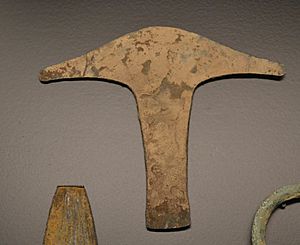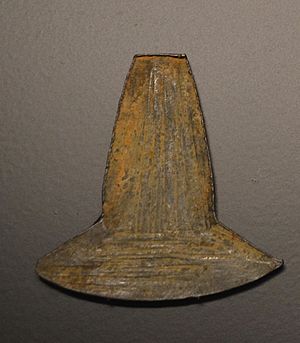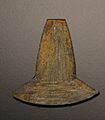Axe-monies facts for kids
Axe-monies (in Spanish: Tajaderos) were special bronze objects shaped like axes. They have been found in both western Mesoamerica (like parts of Mexico) and the northern Andes (like Peru and Ecuador). Experts believe these axe-monies were used for trade between these ancient cultures, even though these places were thousands of miles apart.
Unlike other metal objects found only in one area, axe-monies were found in both regions. Many historians think this system of using axe-monies as money first started around 1000 CE in Peru and Ecuador. People made them by melting bronze and hammering it into thin axe shapes. They often bundled them together, usually in groups of twenty. Since axe-monies are often found in ancient burials, they probably had a special meaning for ceremonies, not just for buying and selling.
Contents
How Ancient People Made Metal Tools
Scientists have often wondered if ancient people in Mesoamerica and the Andes were connected. For example, some early pottery styles from Mesoamerica and Ecuador look similar. Also, some ancient burial styles in Ecuador and western Mesoamerica, called "shaft tombs", are alike.
It is more widely accepted that metalworking ideas from South America influenced Mesoamerica. In South America, there were two main ways of working with metals:
- One way, in Peru, southern Ecuador, and Bolivia, used metals like copper, tin, silver, gold, and arsenic. They made many different tools and objects.
- Another way, in Colombia and southern Central America, focused on gold and copper. They mostly made art, not tools for everyday use.
The metalworking in western Mesoamerica, even though it was closer to Central America, was more like the style from southern Ecuador. For example, the way they made interlocking metal rings was the same in both places. These rings were even found in similar spots in burials, often around the head. Other items like fish-hooks, needles, and tweezers also appeared in both traditions.
Ancient Trade Between Ecuador and Mexico
We know from old Spanish writings that native people in Ecuador used large rafts with sails. They traveled along the northern Andean coast to trade goods. For example, the first king of Lambayeque, a place where axe-monies were made, is said to have arrived there by raft. The Chincha people of Peru and the Manteño people of Ecuador were likely important traders.
There is also strong archaeological proof of trade in Spondylus shells. These shells could be found between Ecuador and the Gulf of Mexico. They were traded to the Andean highlands during the Chavín culture period. Also, old stories from the Balsas River in western Mexico tell of local men whose fathers and grandfathers traded with people who arrived by canoe. These traders sometimes stayed for up to six months. However, we don't have clear archaeological proof yet that Ecuadorians were in Mexico, or Mexicans in Ecuador.
This trading system was very old. Some experts suggest that traders used balsa rafts along the Andean coast from Colombia to Chile as early as 100 BCE. They believe it was possible for these rafts to sail not just along the coast, but also across the open ocean between Ecuador and Michoacán in Mexico.
Experts suggest that traders from South America brought metalworking skills to western Mexico in two main periods. The first was between about 800 and 1250 CE. The second was between about 1250 CE and the Spanish conquest. Axe-monies are found in western Mexico during this second period. However, earlier forms of axe-monies have been found in Ecuador from as early as 800 CE. Even though South American metalworking influenced western Mexico, people there also developed their own unique styles.
Images for kids
See also
 In Spanish: Hachas monedas para niños
In Spanish: Hachas monedas para niños





